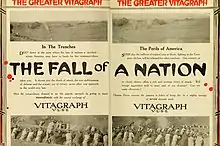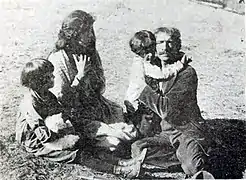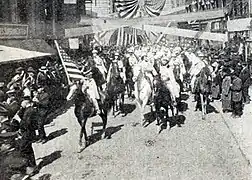The Fall of a Nation
The Fall of a Nation is a 1916 American silent drama film directed by Thomas Dixon Jr., and is a sequel to the 1915 film The Birth of a Nation, directed by D. W. Griffith. Dixon, Jr. attempted to cash in on the success of the controversial first film.[1] The Fall of a Nation is considered to be the first ever film sequel.[2] Based upon The Fall of a Nation, written by the director, the film is now considered lost.[3][4]
| The Fall of a Nation | |
|---|---|
 | |
| Directed by | Thomas Dixon, Jr. |
| Screenplay by | Thomas Dixon, Jr. |
| Based on | The Fall of a Nation by Thomas Dixon, Jr. |
| Starring | Lorraine Huling Percy Standing |
| Music by | Victor Herbert |
| Cinematography | John W. Boyle |
Production company | Dixon Studios |
| Distributed by | V-L-S-E |
Release date |
|
Running time | 7–8 reels |
| Country | United States |
| Language | Silent English intertitles |
Plot
The Fall of a Nation is an attack on the pacifism of William Jennings Bryan and Henry Ford and a plea for American preparedness for war.[5]
America is unprepared for an attack by the "European Confederated Army", a European army headed by Germany. The army invades America and executes children and war veterans. However, America is saved by a pro-war Congressman who raises an army to defeat the invaders with the support of a suffragette. According to the Internet Movie Database, the film is split into three sections: "A nation falls", "The heel of the conqueror" and "The uprising two years later".
- Film stills


Cast
- Lorraine Huling as Virginia Holland
- Percy Standing as Charles Waldron/Prince Karl Von Waldron
- Arthur Shirley as John Vassar
- Flora Macdonald as Angela Benda
- Paul Willis as Billy
- Phil Gastrock as Thomas
- Clarence Geldart as General Arnold
Production
Some battle scenes were filmed in the same location as The Birth of a Nation, at a cost of $31,000.[1]
Soundtrack
The film had a musical score produced by Victor Herbert. The Encyclopædia Britannica states that "this is probably the first original symphonic score composed for a feature film". An earlier music score was composed by Camille Saint-Saëns for the short (15-minute) film The Assassination of the Duke of Guise (1908).[6]
Reception and aftermath
Anthony Slide argues that the film was largely a commercial failure.[7] The production company, Dixon Studios, went bust in 1921, having produced only this film.[1]
See also
References
- Stokes, Melvyn (2007). D.W. Griffith's the Birth of a Nation: A History of the Most Controversial Motion Picture of All Time. Oxford University Press. p. 268. ISBN 978-0-19-533678-8.
- Williams, Gregory Paul (2005). The Story of Hollywood: An Illustrated History. p. 87. ISBN 9780977629909.
- Slide, Anthony (2004). "American Racist: The Life and Films of Thomas Dixon (review)". Project MUSE. Retrieved March 2, 2013.
- Jess-Cooke, Carolyn (February 2, 2009). Film Sequels: Theory and Practice from Hollywood to Bollywood. Edinburgh University Press. p. 30. ISBN 9780748689477. Retrieved May 23, 2016.
- "AMERICA IS INVADED AGAIN IN THE FILMS". The New York Times. 1916-06-07. Retrieved 2009-10-30.
- "The Fall of a Nation (film) – Britannica Online Encyclopedia". Encyclopædia Britannica Online. 2009-05-25. Archived from the original on 2009-09-23. Retrieved 2009-10-30.
- Slide, Anthony (2004). American Racist: The Life and Films of Thomas Dixon. University Press of Kentucky. p. 102. ISBN 0-8131-2328-3.
External links
| Wikimedia Commons has media related to The Fall of a Nation. |
- The Fall of a Nation at IMDb
- Progressive Silent Film List: The Fall of a Nation at silentera.com
